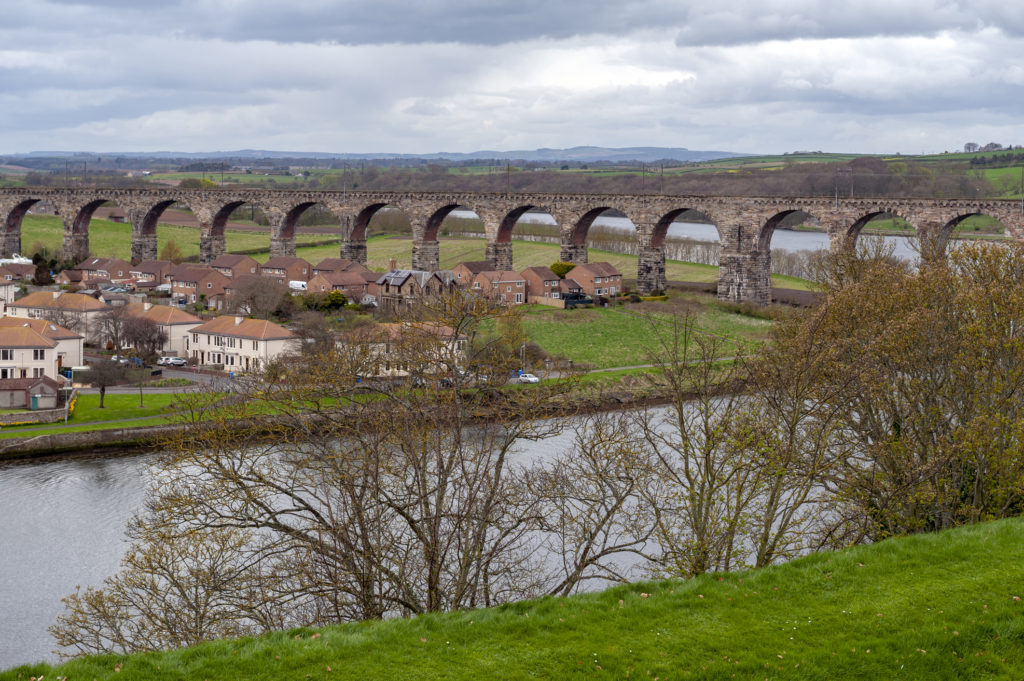The Royal Border Bridge at Berwick-upon-Tweed is a well-loved landmark on the East Coast Main Line, located just to the south of the town’s station.
It is to be repaired throughout 2022 in a major Network Rail project to repair all 28 arches of the Grade I listed viaduct. Work on the scheme began in early January and will continue until November. The structural repairs to masonry and brickwork should mean that the bridge will not require any more major maintenance for the next 30 years.
The viaduct was built between 1847 and 1850 by the Newcastle and Berwick Railway. Designed by famed railway engineer Robert Stephenson, it is 659 metres long carrying the railway 38 metres above the River Tweed on 28 18-metre-span arches.
Comprising 227m3 of masonry and two and a half million bricks, much of the bridge is supported on piled foundations, driven by the then new steam powered pile driving technology.
Originally known as the Tweed Viaduct it was renamed Royal Border Bridge following its formal opening by Queen Victoria and Prince Albert in August 1850, although the England/ Scotland border actually lies two and half miles further north.
The viaduct last received major maintenance between 1993 and 1996, partly funded by English Heritage. This focused on repairs to the 15 land arches and the installation of horizontal anchors through the arch rings. In 2016 an innovative lighting scheme was installed to celebrate its 160th anniversary.

The scope of this year’s project includes works to all 28 arches and will see the installation of tie bars, repairs to pattress plates, replacement of bricks, repointing of brick and stonework, and the resin grouting of cracks. All repair materials have been selected to match the existing structure and agreed with Historic England.
This year’s repairs will all be carried out at height, and a variety of access methods will be used. Roped access systems will provide access in hard-to-reach locations, suspended cradles will be used above the river and mobile access work platforms on the land spans. For the works to the parapets, a scaffold platform will be installed on each side from span 16 to 28. This will be cantilevered from the structure, supported by brackets attached to the spandrels. Access to the scaffold will be from staircase towers within the works compound, on the riverbank.
The timeline of the project will see pairs of arches being worked on, working across the viaduct from the south end, from spans 1 and 2 in January to spans 26 to 28 in September. November has been allocated for any additional works that may be identified and the works will be completed by the end of that month.
The Royal Border Bridge is located along the edge of Berwick-upon-Tweed and close to residential properties on the Riverdene Estate, which lies directly below the bridge. The construction contractor, Story Contracting, is taking measures to mitigate disruption to residents. Noise will be reduced using acoustic screens around plant and the compound, the use of solar panel generators, and ‘white noise’ reversing alarms, avoiding the usual annoying beeping of manoeuvring plant and vehicles. The site team has already built a good relationship with the local community and is working with the Berwick Youth Project on volunteering projects.
The repair works in the 1990s encountered bats and birds roosting in the structure. To minimise the impact of this year’s works, ecological assessments have been carried out to identify risk areas and working methods and sequencing will reflect these.
Cutting out perished mortar produces great volumes of dust. Vacuum tools will be used to capture this, avoiding any contamination of the river and environment. Story Contracting’s working methods have all been agreed with Natural England and the Environment Agency to minimise the impacts of the project.

